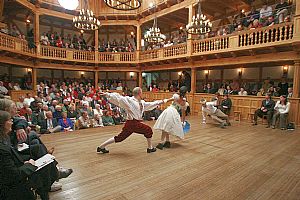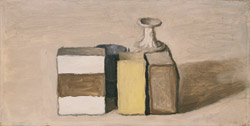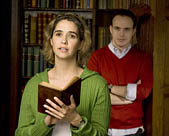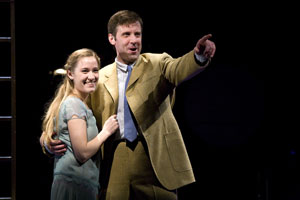GUILDENSTERN: You’re familiar with the tragedies of antiquity, are you? The great homicidal classics? Matri, patri, fratri, sorrori, uxori and it goes without saying–
ROSENCRANTZ: Saucy–
GUILDENSTERN: –Suicidal–hm? Maidens aspiring to godheads–
ROSENCRANTZ: And vice versa–
GUILDENSTERN: Your kind of thing, is it?
PLAYER KING: Well, no, I can’t say it is, really. We’re more of the blood, love and rhetoric school.
GUILDENSTERN: Well, I’ll leave the choice to you, if there is anything to choose between them.
PLAYER KING: They’re hardly divisible, sir–well, I can do you blood and love without the rhetoric, and I can do you blood and rhetoric without the love, and I can do you all three concurrent or consecutive, but I can’t do you love and rhetoric without the blood. Blood is compulsory–they’re all blood, you see.
Tom Stoppard, Rosencrantz and Guildenstern Are Dead
Archives for May 2009
TT: Cross-country run (II)
 On Friday Mrs. T and I drove down to Staunton, Virginia, where we lunched on Superburgers at Wright’s Dairy-Rite, a drive-in that has been doing business in the same building since 1952, and saw another Tom Stoppard play, Rosencrantz and Guildenstern Are Dead, in another Elizabethan-style theater, the Blackfriars Playhouse, which I visited for the first time in 2006:
On Friday Mrs. T and I drove down to Staunton, Virginia, where we lunched on Superburgers at Wright’s Dairy-Rite, a drive-in that has been doing business in the same building since 1952, and saw another Tom Stoppard play, Rosencrantz and Guildenstern Are Dead, in another Elizabethan-style theater, the Blackfriars Playhouse, which I visited for the first time in 2006:
In theater, seeing is believing, and the best way to learn about 17th-century theatrical performance practices is to watch a Shakespeare play acted on a modern re-creation of an Elizabethan-style stage….The U.S. is home to a half-dozen such houses, including the indoor theater at the Folger Shakespeare Library in Washington, D.C., and the open-air theaters that I saw earlier this year at the Oregon Shakespeare and Utah Shakespearean Festivals. Most of the American replicas, however, are variously modernized structures that incorporate such anachronistic devices as theatrical lighting. If you want to see the real thing–and to see it used in a convincing way–the place to go is Staunton, home of the American Shakespeare Center, whose performances are given in a dazzlingly exact re-creation of the Blackfriars Playhouse, originally built in London in 1596….
To pass through the lobby doors into the 300-seat auditorium is like jumping into Mr. Peabody’s Wayback Machine and setting the controls for 1600, with some allowances made for fire safety. Actors and audience are lit by the same electric chandeliers–there are no spotlights–and if you’re fortunate enough to hold a ticket for one of the 12 “Lord’s Chairs” placed on either side of the stage, you’ll be close enough to the players to reach out and touch them.
The opportunity to review two Stoppard plays performed on consecutive nights in two different Elizabethan-style theaters was, of course, irresistible, and I didn’t even consider resisting it, even though I knew it would involve a fair-sized chunk of long-distance driving, there being no practical way to get from Washington to Staunton other than in a car. The next morning I took Mrs. T back to Union Station, from whence she departed for Connecticut. I then drove to Dulles International Airport and flew to Houston, Texas, by way of Charlotte, North Carolina, to begin the second leg of my cross-country regional-theater pilgrimage.
Too much travel in one day makes my head spin–I woke up an hour ahead of my wake-up call in Staunton–and it wasn’t until I landed in Houston that I started to calm down. All told, I spent thirteen hours on the move last Saturday, including a twenty-minute jog from one end of the Charlotte airport to the other (for once, the word literally is applicable). As soon as I picked up my rental car in Houston, I drove straight to La Mexicana, a neighborhood joint recommended by Michael Stern, and dined on fish tacos laced with fresh cilantro and lime. Then I found my hotel, ascended to the twenty-third floor, called Mrs. T and my mother, and fell into bed.
(To be continued)
TT: Try, try again
I asked about this without effect back in January, so allow me to repeat myself: I’m curious about the current whereabouts of two people whom I knew in college three decades ago, a violinist named Laura Gutsch and an oboe player named Michelle Rock. Both lived in the Kansas City area. Laura married and moved away, but I know nothing more about Michelle, who may or may not still be in Kansas City.
If anyone out there knows either of these women, would you be so kind as to send them a link to this posting?
TT: Almanac (apropos of The Letter, I)
“I always think of melodrama as the thing we are all capable of that’s swept under the rug.”
Sidney Lumet (quoted on imdb.com)
TT: Cross-country run (I)
On Wednesday Mrs. T and I took the Acela Express to Washington, D.C., picked up a rental car at the train station, and drove to Arlington, Virginia, to see Signature Theatre’s production of Giant, the new Michael John LaChiusa-Sybille Pearson musical version of Edna Ferber’s 1952 novel. My Wall Street Journal review, unlike most of the others that I’ve seen to date, was strongly positive. I think Giant is a show of the first importance, and I wish I’d had time to see it twice, something I almost never get to do.
 The next day we strolled from our hotel to the Phillips Collection to see Morandi: Master of Modern Still Life, an exhibition of sixty paintings and etchings to which I’ve been looking forward ever since it was announced last year. (The Phillips, not incidentally, happens to own one of my favorite Morandis, a 1953 still life that is one of the finest pieces in the show, which is up through May 24.) I’ve written a fair amount about Morandi in this space, most recently in connection with the Metropolitan Museum’s 2008 retrospective, a once-in-a-lifetime event that nonetheless disappointed me, not because the paintings weren’t beautiful but because they were presented in a way that I found problematic. Not so the Phillips show, which gets everything right. The size of the show is ideal–large enough to suggest Morandi’s range without blunting your perception of the individual pieces–and though the galleries were fairly full of spectators, everyone was properly quiet and attentive.
The next day we strolled from our hotel to the Phillips Collection to see Morandi: Master of Modern Still Life, an exhibition of sixty paintings and etchings to which I’ve been looking forward ever since it was announced last year. (The Phillips, not incidentally, happens to own one of my favorite Morandis, a 1953 still life that is one of the finest pieces in the show, which is up through May 24.) I’ve written a fair amount about Morandi in this space, most recently in connection with the Metropolitan Museum’s 2008 retrospective, a once-in-a-lifetime event that nonetheless disappointed me, not because the paintings weren’t beautiful but because they were presented in a way that I found problematic. Not so the Phillips show, which gets everything right. The size of the show is ideal–large enough to suggest Morandi’s range without blunting your perception of the individual pieces–and though the galleries were fairly full of spectators, everyone was properly quiet and attentive.
Afterward we had dinner at the home of Megan McArdle, who bills herself as “the world’s tallest female econoblogger,” and her boyfriend Peter Suderman, a comparably classy writer. I love to eat out on the road, but it’s always nicer to dine in a friend’s backyard garden, and Megan, in addition to being very tall and very smart, is also a terrific cook, so a good time was had by all.
 The four of us then went to the Folger Theatre to see Aaron Posner’s revival of Tom Stoppard’s Arcadia, a play that is close to my heart. My review hasn’t run yet, so you’ll have to wait to find out what I thought of the production (Peter Marks of the Washington Post gave it a hat-in-the-air rave). Instead, I’ll reprint part of what I wrote about Arcadia when I last saw it performed by Chicago’s Court Theatre two seasons ago:
The four of us then went to the Folger Theatre to see Aaron Posner’s revival of Tom Stoppard’s Arcadia, a play that is close to my heart. My review hasn’t run yet, so you’ll have to wait to find out what I thought of the production (Peter Marks of the Washington Post gave it a hat-in-the-air rave). Instead, I’ll reprint part of what I wrote about Arcadia when I last saw it performed by Chicago’s Court Theatre two seasons ago:
In theory Arcadia, a highbrow whodunit whose plot charges back and forth between 1809 and the present, ought to be hard to unravel. On stage it plays like a high-speed boulevard comedy heavily salted with wicked punchlines. Yet for all its fizzing fun, Arcadia is also a deeply serious meditation on what it means to live in the shadow of modernity, and the climactic scene, in which a fey child prodigy and her tutor reflect on man’s fate, is hauntingly hopeful: “When we have found all the mysteries and lost all the meaning, we will be alone, on an empty shore.” “Then we will dance. Is this a waltz?”
I wish I’d written that.
(To be continued)
* * *
Here’s a video about “Morandi: Master of Modern Still Life”:
TT: Almanac
“The bad end unhappily, the good unluckily. That is what tragedy means.”
Tom Stoppard, Rosencrantz and Guildenstern Are Dead
CAAF: Breathless
I’ve read a couple reviews of Angels & Demons but thus far have not had my most burning question about the movie answered: Will Robert Langdon, Harvard symbologist, once again be forced to face down his old nemesis, claustrophobia, in his scholarly pursuit of truth?
Because I’m pretty much done in by the very idea of Robert Langdon, Harvard symbologist, whenever he appears on the scene in his khakis and his black turtleneck, but once you add in the gripping fear of enclosed spaces — gamely portrayed by Tom Hanks in The Da Vinci Code with gritted teeth and tiny, earnest beads of sweat — it takes it to a whole other level of adventure.
TT: A really, really big show
In today’s Wall Street Journal drama column I report on two first-rate out-of-town shows, Giant at Arlington’s Signature Theatre and Old Times at Chicago’s Remy Bumppo Theatre Company. Here’s an excerpt.
* * *
For some playgoers, the most noteworthy piece of information about “Giant,” Michael John LaChiusa’s musical version of Edna Ferber’s mammoth 1952 novel, will be that it runs for three hours and 45 minutes. Even for an opera, that’s on the long side, and in the knock-’em-dead world of musical comedy, it’s endless. Yet Signature Theatre, which just won a well-deserved regional-theater Tony Award, has thrown caution to the winds and dared to put Mr. LaChiusa’s new show on its smallish stage–with immensely impressive results. This is a long show that doesn’t feel long, with a score so rich and varied that you’ll relish every bar.
 Ferber’s multigenerational middlebrow epic about a family of Texas cattle ranchers is best known nowadays from George Stevens’ star-studded 1956 film version. Sybille Pearson, however, has gone back to the source in writing the book for “Giant,” and her three-act adaptation conveys the essence of the 416-page novel without getting bogged down in Ferber’s flat-textured, tin-eared prose. The story comes through clearly, and it’s a good one, an event-packed tale of a wealthy rancher (Lewis Cleale) whose young Virginia bride (Betsy Morgan), stunned by the size and strangeness of her new home, spends the rest of her life trying to come to terms with Texas.
Ferber’s multigenerational middlebrow epic about a family of Texas cattle ranchers is best known nowadays from George Stevens’ star-studded 1956 film version. Sybille Pearson, however, has gone back to the source in writing the book for “Giant,” and her three-act adaptation conveys the essence of the 416-page novel without getting bogged down in Ferber’s flat-textured, tin-eared prose. The story comes through clearly, and it’s a good one, an event-packed tale of a wealthy rancher (Lewis Cleale) whose young Virginia bride (Betsy Morgan), stunned by the size and strangeness of her new home, spends the rest of her life trying to come to terms with Texas.
The pull of the plot is obviously an important part of what makes “Giant” work on stage, but it’s the marvelous songs that are the heart of the matter. From the spacious, unhurried lyricism of “Lost in Her Woods” to the sock-hop rock of “Jump,” the score of “Giant” cuts a wide swath of stylistic terrain. Yet Mr. LaChiusa isn’t just trying on idioms for size–he is at home in all the musical languages to which he turns his hand–and his plain-spoken lyrics propel the action so decisively that “Giant” seems far shorter than it is….
Time was when Harold Pinter’s shorthand dialogue struck most people as impenetrably mysterious–and times, truth to tell, haven’t changed all that much. Yet his best plays continue to make a powerful impression, and “Old Times,” first seen on Broadway in 1971, has even become something of a regional-theater staple in recent years, partly because it can be produced so cheaply (three actors, one simple set) and partly because it’s so theatrically effective. Pinter never wrote anything more potent than the enigmatic story of Deeley and Kate, an uneasily married couple whose life is disrupted by a visit from Anna, who knew Kate 20 years ago and appears (or maybe not) to have been romantically involved with her. Remy Bumppo Theatre, one of my favorite Chicago companies, is presenting this icy sparring match in an exceptionally satisfying production that has been staged with surgical skill by James Bohnen, the company’s artistic director…
* * *
Read the whole thing here.
